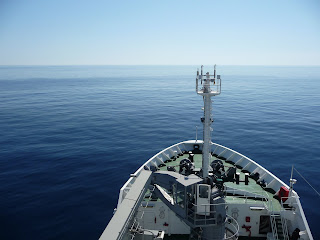
Today marks the end of operations for MED-09 after over 5,000 nautical miles covered across the western Mediterranean Sea. We could not try to tag animals today since we needed to leave the operational area by evening, but we attempted to run some additional visual and acoustic surveys to add to the biological data already obtained. The seas were not friendly, however, and as we got further north they became rougher and we had to break off the surveys and begin the trek back to LaSpezia. We had sustained winds of 35 knots, with gusts of over 40 with large waves rolling the ship most of the day as we left.
While all of us are looking forward to being back on land for different reasons, we are also sad to see this project come to an end. We have had assembled, on an outstanding and quiet research vessel, an all-star team of specialized experts from around the world. What we have been trying to do is incredibly difficult -- measuring behavior in some of the most challenging animals on Earth to study. Certainly there is some disappointment that we were not able to tag and conduct controlled exposure experiments on beaked whales. But that is counterbalanced by some of the significant accomplishments that were made in this project, many of them related to improvements in methodology and technology in working with such difficult species.
Perhaps our most significant accomplishment was refining and demonstrating the ability to use an integration of visual and multiple acoustic methodologies to follow focal groups of beaked whales over multiple dives for hours. This was the first BRS project for beaked whales off of an acoustic listening range where there are many hydrophones mounted on the bottom. All our assets were based on the main vessel, and we demonstrated that we could use them in an integrated way to track animals that dive for long periods and cover large areas. A key part of this integration was the development of custom geospatial software for displaying the visual and acoustic animal detection data along with the position of the ship, tag boat, and important ocean features. This capability proved to be essential for real-time decision making in tracking focal animal groups. Lessons learned in developing and refining these capabilities will be imperative in subsequent efforts to track and study beaked whales and other cetaceans.
Additionally, we made several major contributions to understanding the biology and oceanography of three different areas of the western Mediterranean that have not been extensively studied. We made nearly 500 sightings of over 5,000 individual cetaceans from eight species. When and where these animals were seen relative to the physical, biological, and acoustic environments will be very useful in developing and refining predictive habitat models for where marine mammals will occur in the Mediterranean Sea and other areas. Our oceanographic data (see post of 27 August) will be critical in that regard. So to will the large number of passive acoustic measurements made from sonobuoys to measure ambient noise be useful in assessing the extent to which human sounds (e.g., from the dense shipping traffic we saw in many areas) affect the acoustic environment for marine mammals who depend heavily on the use of sound.
Summary information regarding our efforts and accomplishments will be publicly available at a later date. Each of the participating organizations will be provided a link to this information and a subsequent message will be posted to this blog when it is available. We expect that many of our measurements will be used by participating researchers and graduate students in different areas and results will ultimately be presented in scientific meetings and journals.
Thank you to those who have been following the blog for this project. We appreciate the interest in this project. We would like to acknowledge the outstanding crew of the NATO research vessel Alliance that has been our home for the last six weeks. From the captain on down, it is an outstanding platform from which to work with an extremely precise and professional crew. Efforts to better understand the behavior of marine mammals and how sound we make in the oceans can affect and harm them will continue in different ways and places around the world, and it will be served by the efforts of the many dedicated people involved in this project (the team from the second leg appears below).







